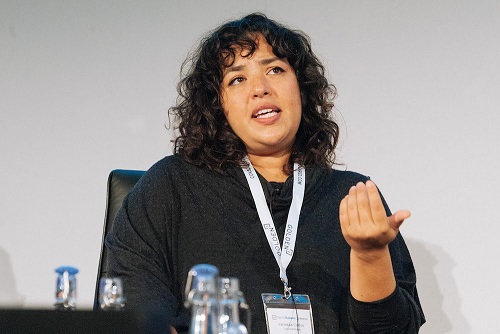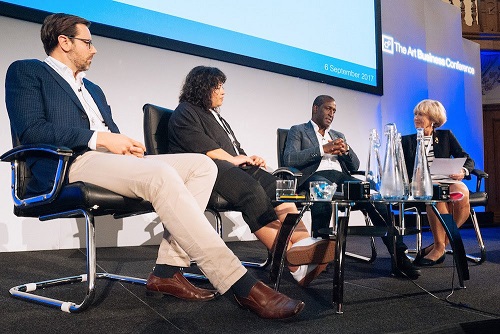정준모


From left to right, the panelists Preston Benson, Vanessa Carlos, and Lennox Cato, and the moderator Georgina Adam. Courtesy the Art Business Conference.
2) But It’s Not Just About Money
“The challenges of small and mid-sized galleries are well documented: we all know that overheads and the expectations compared to the prices of the works for sale are very unmatched,” Carlos began.
“For me, the problem is the lack of responsibility on every level—from galleries, collectors, and artists—in terms of how we support artists and galleries at every stage of their career. Everyone likes to be very shocked when galleries close, but it is very simple.”
Carlos read an excerpt from the emotional farewell letter recently penned by Basel dealer Jean-Claude Freymond-Guth, in which he described the sense that a system that catered mainly to an isolated elite had become alienating in a way that didn’t merit sacrifice.
“It’s not just about rents and fairs being expensive—we know that,” Carlos said. “It’s about a general attitude about what is art, what do we want out of art, and how do we have a responsibility to ensure that we get that.”
3) The Online Revolution Is Overrated
For years, web sales have been touted as the solution to circumvent the problems posed by the brick-and-mortar model. Yet, when asked by Adam about the importance of online sales, Carlos was supportive—but not overenthusiastic:
“Online sales are important, and in fact a lot of my sales happen online through .jpgs and .pdfs. But a physical space is always going to be important for me because an artist makes a lot of the work in the gallery space, which is also a place for experimentation. And of course, the physical experience of art is one of its greatest joys, so why would you want to remove that?”
“Having said that, online is definitely important,” Carlos added, “although I don’t think that any of the online platforms have cracked the formula yet.”
4) The Condo Model Is Successful, and Spreading
The Condo initiative, which sees galleries in a target city team up to host out-of-town galleries for pop-up exhibitions, has been much-touted as an “elegant solution” to the crisis.
Condo answers, said Carlos, not just to the financial problems with the system, but also to the lack of excitement that comes with having to play it safe: “I started by thinking about how art fairs limit the level of experimentation and risk that artists and galleries can take.”
“I thought that we all have these beautiful spaces that we are renting, so instead of also hiring these temporary booths around the world, I asked a group of London galleries to act as hosts and share their spaces with visiting international galleries. And it’s a nonprofit project, so hosts offer their spaces in kind. […] It’s a much smarter way to show in a city where you might have not that many contacts, as the hosts are also offering their networks, which they have built over many years.”
“So we launched Condo in London 2016 and there was amazing energy. Some dealers told me that it reminded them of why they had opened in a gallery in the first place. And what’s really exciting is that New York approached, so we did it there in the summer, and now we are going to do Mexico City in April. I want to do Asia [a Shanghai iteration is in the works], Europe, North America, South America, and maybe Middle East.”

From left to right, Preston Benson, Vanessa Carlos, Georgina Adam, and Lennox Cato. Courtesy the Art Business Conference.
5) The Age of the “Pointless Art Fair” Is Over
“Condo won’t replace art fairs, but it replaces the pointless art fairs… I hope!” Carlos said. “Collectors want to go either to a big, top-quality fair like Art Basel, or to a small, carefully selected one. What they don’t want is to go to 10 mediocre fairs. And likewise with galleries: galleries don’t need to do more than three or four fairs a year, but some are doing one a month.”
6) But It’s Still About Elite Branding
The only unsolvable problem that Carlos has found in the new model, she said, is scale:
“By definition, Condo has to be quite small. I can’t include everyone who wants to be included. More and more people are asking me to take part, but for me the whole problem with a lot of fairs is that it is too much: I can’t look, and see, and digest all of that. And with Condo I wanted to create something that facilitated looking and meaningful conversations, and that’s why it can’t be enormous.”
That doesn’t mean that the idea, however, can’t go farther. “What I’ve been trying to do is, when other cities where I don’t want to do a Condo contact me, I suggest that they do their own version, and I’m happy to help. I just don’t want it to be under the Condo name.”
FAMILY SITE
copyright © 2012 KIM DALJIN ART RESEARCH AND CONSULTING. All Rights reserved
이 페이지는 서울아트가이드에서 제공됩니다. This page provided by Seoul Art Guide.
다음 브라우져 에서 최적화 되어있습니다. This page optimized for these browsers. over IE 8, Chrome, FireFox, Safari